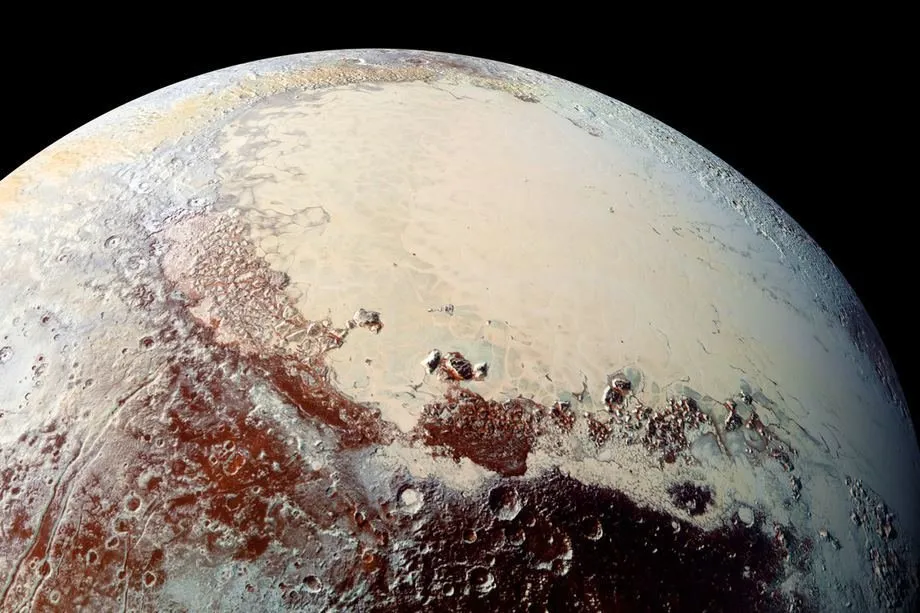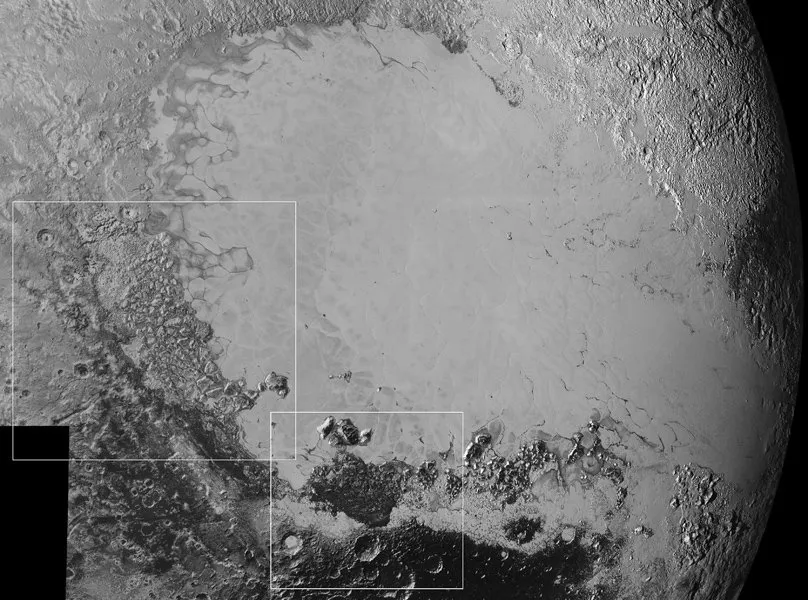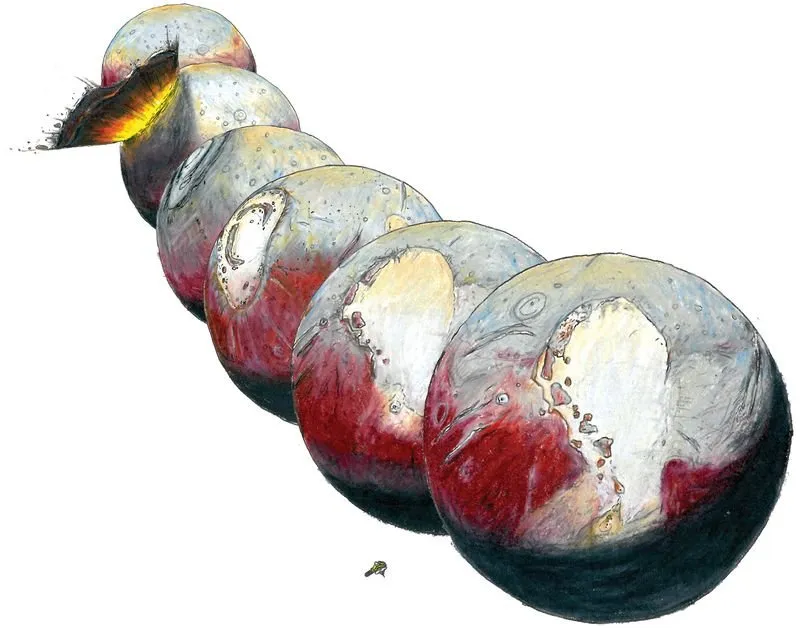
Pluto - one of the most remote and coldest objects in the solar system from those that are relatively well understood by man. The surface of the dwarf planet covered with nitrogen and methane ice with a splash of water ice. Pluto may have nitrogen and sea kriovulkany. In general, this icy world is not dead. Here, there are certain geological processes, the surface of the dwarf planet is not static.
Recently, two teams of researchers published the results of analysis of the data transmitted by the probe New Horizons to Earth. Scientists studied, in particular, the most conspicuous object in Pluto - Sputnik Planitia. As it turned out, this region is interesting not only because of its shape.
Sam Sputnik Planitia - a huge basin filled with nitrogen ice. This ice is more dense than water ice, so the latter is on the surface of frozen nitrogen. Experts say that at this point found massive amounts of frozen water ice. Moreover, they are not static but moving. This entire region is dynamic, its surface moves, the individual layers are mixed. Perhaps the reason for this - the radioactive core of Pluto, warms the overlying layers.
Experts talk about more interesting things. In their view, the region itself should not exist in this place. The fact that Pluto and Charon, his companion, tidal phenomena are related. Pluto, Charon always faces one of its side. And on the reverse side is Sputnik Planitia. If you draw a straight line through the centers of Charon and Pluto, this line intersects the region described. The chances that the region was formed in this place, is very small. Everything indicates that the plateau, and Charon are on a single "tidal axis."

The dynamics of the situation "heart" of Pluto. Source: NASA / Johns Hopkins University Applied Physics Laboratory / Southwest Research Institute
But gravitational mechanics can explain everything. As a result of tidal phenomena arising from the interaction of Pluto and Charon, a dwarf planet just might turn to the other side of Charon. If the surface of Sputnik Planitia was less dense than the rest of the surface of the ice planet, the region would be the north pole, just as the least dense of the Moon region has its south pole. But if we assume that Sputnik Planitia denser than the rest of the surface of Pluto, it all falls into place - in this case, the region should be exactly where he is right now. The most interesting thing is that this object could cause a displacement of the axis of rotation of Pluto at 60 degrees. Formed as Sputnik Planitia, most likely in the northern hemisphere on the opposite side of Pluto's Charon.
The gravitational interaction of two dwarf planets - a significant factor of influence that changes the voltage of the upper layers of Pluto, and affects its rotation axis.
Here, the second team of scientists has identified a discrepancy. The fact is that the ice in a nitrogen Pluto really denser water ice. But still, this is not enough to develop a dwarf planet. Both teams of scientists calculated that this nitrogen ice thickness should be up to 50 km. But in fact, the thickness of the ice crust region - not more than 5 km.

The smooth, icy plain called Sputnik Planum sits in an old impact basin.
But what in this case may be the reason that Sputnik Planitia is now exactly where is? Perhaps the reason is that under the ice there is a liquid ocean. If this is true, then the ocean made ice crust is thinner. Most likely, this is not an ocean of methane or nitrogen, and liquid water, which has replaced a significant part of the ice. Since liquid water is heavier than ice, which it has replaced, and it was the cause of Pluto's rotation. Repeated analysis of the data showed that the thickness of the liquid ice water above the ocean can be 7 kilometers.
The ocean beneath the surface of Pluto, experts say, is different from Europe or the Earth's oceans ocean ice. The water is extremely salty, it is rich in nitrogen compounds.
Water - an important factor in the displacement of Pluto around the axis of its rotation. But nitrogen ice, located on the surface of Sputnik Planitia, is also very important in the dynamics of the rotation of the dwarf planet. Specifically, the amount of nitrogen is important at this point of ice. And it changes due to temperature fluctuations, changes are most active when Sputnik Planitia is closer to the equator. All this creates a probability of the existence of a complex cycle change Pluto's status.
"If volatile substances (eg nitrogen), go to Sputnik Planitia in the framework of seasonal changes, this may be the cause of small fluctuations of the planet" - the authors conclude.

A possible way of forming the region. Source: James Tuttle Keane
How did the "heart" itself? As previously reported hypothesis that billions of years ago, a certain object moving at high speed, crashed into Pluto, and left on the planetoid eternal reminder of itself - wide crater 825 kilometers. But instead of being turned into an ugly scar on the body of the dwarf planet, crater transformed into an unusual object that we, the people, reminds icy heart.
The area of the crater is about one-third of the surface of Pluto. The ice field Sputnik Planitia located just within the impact crater. Perhaps water ice and makes the region white.
DOI: 10.1038/nature20120, 10.1038/nature20148
Referenced Materials:
- http://www.nature.com/nature/journal/vaop/ncurrent/full/nature20120.html
- http://pluto.jhuapl.edu/
- http://www.nature.com/nature/journal/vaop/ncurrent/full/nature20148.html
- http://phenomena.nationalgeographic.com/2015/11/13/plutos-heart-has-been-broken-for-billions-of-years/?utm_content=buffer18ef3&utm_medium=social&utm_source=twitter.com&utm_campaign=buffer